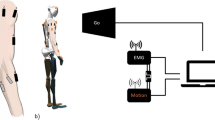Abstract
This paper presents realistic avatar movements using a limited number of sensors. An inverse kinematics algorithm, SHAKF, is used to configure an articulated skeletal model, and a neural network is employed to predict the movement of joints not bearing sensors. The results show that the neural network is able to give a very close approximation to the actual rotation of the joints. This allows a substantial reduction in the number of sensors to configure an articulated human skeletal model.
Similar content being viewed by others
References
Kornreich D, Benbenisti Y, Mitchell HB, Schaefer P. Normalization schemes in a neural network image compression algorithm. Signal Processing Image Communication 1997; 10: 269–278
Li B, Goddu G, Chow MY. Enhancement of the performance of a neural network based motor fault detector using graphical data analysis techniques. In: IEEE World Congress on Computation Intelligence, 1998; 63–68
Lo SCB, Chan HP, Lin JS, Li H, Freedman MT, Mun SK. Artificial convolution neural network for medical image pattern recognition. Neural Networks 1995; 8: 1201–1214
Kim DS, Lee SY. Intelligent judge neural network for speech recognition. Neural Network Letters 1994; 1: 17–20
Zhao J, Badler NI. Real time inverse kinematics with joint limits and spatial constraints. Technical Report, MS-CIS-89-09, Graphics Lab 27, January 1989
Boulic R, Mas R, Thalmann D. Inverse kinetics for center of mass position control and posture optimization. In: Proceedings of European Workshop on Combined Real and Synthetic Image Processing for Broadcast and Video Production. Hamburg, November 1994
Tang W, Cavazza M, Mountain D, Earnshaw R. A constrained inverse technique for rea-time motion capture animation. Visual Computer 1999; 15: 413–425
Verlet L. Computer experiments on classical fluids; I. Thermodynamical properties of Lennard-Jones molecules. Phys Rev 1967, 159: 98–103
Ryckaert J, Ciccotti G, Berendsen HJ. Numerical integration of the Cartesian equations of motion of a system with constraints: molecular dynamics of nalkanes. Journal of Computational Physics 1977; 23: 327–341
Kastenmeier T, Vesely FJ. Numerical robot kinematics based on stochastic and molecular simulation methods. Robotica 1996; 14: 329–337
Novakovic ZR, Nemec B. A solution to the inverse kinematics problem using the sliding mode. IEEE Transactions on Robotics Automation 1990; 6: 247–252
Perez CA, Holzmann CA, Morelli I. Optimazation of 1 and 2 hidden layer neural network architecture for handwritten digit recognition. IEEE International Congress on Systems; Man and Cybernetics Intelligent Systems for the 21st Century, Vancouver, Canada, 22–25 October 1995, 2795–2799
Lippmann RP. Introduction to computing with neural nets. Speech and Signal Processing Magazine 1987; 4: 4–22
Amin H, Curtis KM, Hayes-Gill BR. Piecewise linear approximation applied to nonlinear function of a neural network. IEE Proc of Circuits Devices and Systems 1997; 144: 313–317
Ascension Technology Corporation, PO Box 527, Burlington, VT 05402, USA
Yw LI, Vanespen P. Study of the influence of neural network parameters on the performance characteristics in pattern recognition. Chemometrics and Intelligent Laboratory Systems 1994; 25: 241–248
Wanas N, Auda G, Kamel MS, Karray F. On the optimal number of hidden nodes in a neural network. 11th Canadian Conference on Electrical and Computer Engineering, Waterloo, Canada, May 1998, 918–921
McDonnell JR, Waagen D. Determining neural network hidden layer size using evolutionary programming. World Congress on Neural Networks (WCNN'93). Portland, OR, 11–15 Jul 1993, III564–III567
Author information
Authors and Affiliations
Corresponding authors
Rights and permissions
About this article
Cite this article
Amin, H., Earnshaw, R.A. Enhanced avatar control using neural networks. Virtual Reality 5, 47–53 (2000). https://doi.org/10.1007/BF01418976
Issue Date:
DOI: https://doi.org/10.1007/BF01418976




